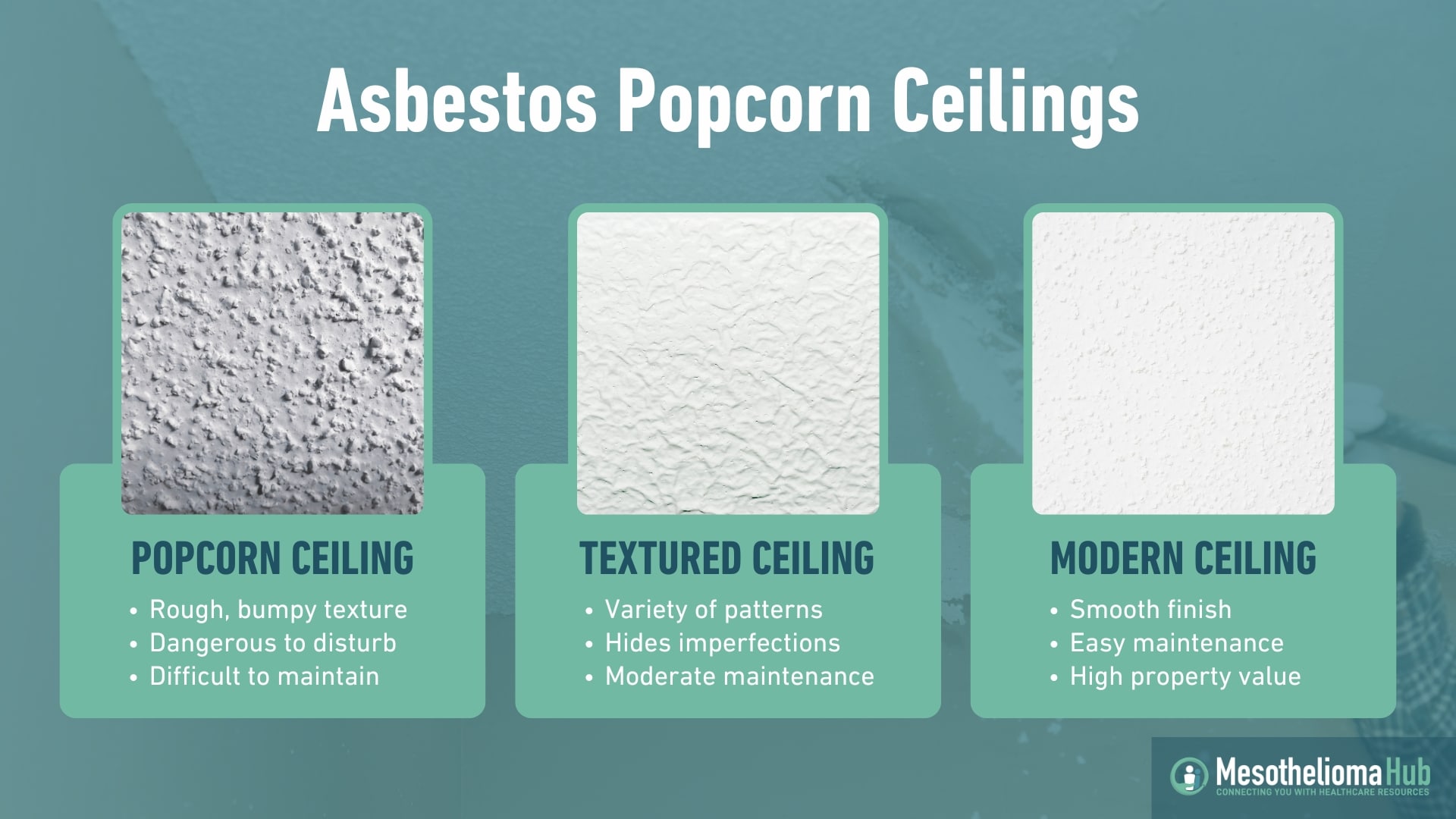The risk of asbestos poisoning from popcorn ceilings is significantly higher in homes and apartments built during or before the 1980s. Eventually, textured paints were banned by federal regulations. Yet, asbestos-containing materials were still built into several areas of homes for soundproofing and fire resistance.

Popcorn ceilings are a type of spray-on textured paint once manufactured with dangerous amounts of asbestos. Textured ceilings are also known as stucco, stipple, cottage cheese, and acoustic ceilings. Initially, the style became popular in the 1950s – when asbestos insulation use was similarly common – because it was easy to install and offered some sound- and fireproofing.
Some popcorn ceilings contain up to 10% asbestos contamination.
Not all popcorn ceilings have asbestos, yet those built during and before the 1980s may have a high risk for contamination. How dangerous an asbestos-containing textured paint is, depends on its overall condition. Usually, materials in good condition (with no tears, water damage, or crumbling areas) should be left alone and checked periodically.
For homeowners, if you find out your ceilings are contaminated with the cancer causing carcinogen, you have three options:
How to tell if popcorn ceiling has asbestos? Normally, popcorn ceiling is a white paint peppered with small, popcorn-like kernels. There’s no way to tell if your textured paint was made with asbestos just by looking at it. The paint’s asbestos fibers are 1,200 times thinner than a human hair. So, you won’t be able to see the toxic fibers if they are released into the air either.
Other asbestos-containing spray-on textured paints come in a variety of colors. In addition to ceilings, these paints were used on walls and some siding. Most of these products were banned by federal regulations beginning in the 1970s. However, buildings and homes built around this time may have asbestos in popcorn ceilings and several other places.
Additionally, old textured paints are easily broken and crumbled when touched too hard. Consequently, the Environmental Protection Agency (EPA) suggests leaving materials alone unless you’re wearing the proper protective gear and clean up afterward.
For years, companies manufactured spray-applied textured materials with asbestos. Yet, because spray-on paints are easily inhaled by workers installing them and people living with them, they received early regulatory bans.
Timeline of Popcorn Ceiling Asbestos Regulations
How to test popcorn ceiling for asbestos? Currently, asbestos testing is the only way to prove the presence of asbestos in popcorn ceilings. Due to the risk of toxic exposure, the EPA recommends hiring a professional to test materials and the air in your home for contamination. Often, an asbestos tester can tell you how much it will cost to remove asbestos-contaminated materials. However, consider hiring a separate company for asbestos removal or encapsulation to avoid a conflict of interest.
According to the EPA, it’s safest to assume materials contain asbestos and move forward with one of three options:
| Encasement (covering) | Cover the asbestos popcorn ceiling with ceiling panels or vinyl paint so dust cannot escape. |
| Encapsulation (sealing) | Sealing asbestos-containing materials with an adhesive sealant to bind fibers together. Encapsulation can make later renovations more difficult. |
| Removal (full abatement) | Completely removing asbestos materials. Projects are often expensive and require full-body protective gear to safely finish. |
The latency period between exposure and the first symptoms of asbestos-caused illnesses can last between 5 and 40 years. If exposed, you won’t experience any immediate symptoms of asbestos poisoning. Years later, you may develop a cough or abdominal swelling from asbestos-related side effects.
If you have any related symptoms, talk with your doctor as soon as possible. Being diagnosed at a cancer medical center with an asbestos-caused disease often qualifies individuals for legal compensation.
Destiny Bezrutczyk is a content writer from Iowa and has earned a Bachelor’s in English Language and Literature from Texas Tech University. After working as a freelance script and blog writer, she began writing content for tech startups. Maintaining a passion for words, she took on a variety of projects where her writing could help people. She enjoys spicy food and video games about robots.
Cahill, Mike. (2021). Should You Buy a House with Popcorn Ceilings? Retrieved on June 30, 2021, from https://redfin.com/blog/should-you-buy-a-house-with-popcorn-ceilings/
JSE Labs. (2021). When to Test for Asbestos in Popcorn Ceilings. Retrieved on June 9, 2021, from https://jselabs.com/blog/popcorn-ceiling-asbestos/
Puget Sound Clean Air Agency. (n.d.). How to Properly Remove Spray-on “Popcorn” Ceilings From Owner-Occupied, Single-Family Residences Only. Retrieved on June 10, 2021, fromhttps://pscleanair.gov/DocumentCenter/View/372/Properly-Remove-Spray-on-Popcorn-Ceilings—-Owner-Occupied-Single-Family-Residences-PDF
United States Consumer Product Safety Commission. (n.d.). Asbestos In The Home. Retrieved on June 10, 2021, from https://cpsc.gov/safety-education/safety-guides/home/asbestos-home
United States Environmental Protection Agency. (2018). Asbestos Ban and Phase-Out Federal Register Notices. Retrieved on June 10, 2021, from https://epa.gov/asbestos/asbestos-ban-and-phase-out-federal-register-notices
United States Environmental Protection Agency. (2019). List of Uses Covered under April 2019 Final Rule; Restrictions on Discontinued Uses of Asbestos. Retrieved on June 10, 2021, from https://epa.gov/asbestos/list-uses-covered-under-april-2019-final-rule-restrictions-discontinued-uses-asbestos
United States Environmental Protection Agency. (2020). EPA Actions to Protect the Public from Exposure to Asbestos. Retrieved on June 9, 2021, from https://epa.gov/asbestos/epa-actions-protect-public-exposure-asbestos